Plantar Fasciitis: Causes, Symptoms, and Treatments
Plantar Fasciitis: Causes, Symptoms and Treatment Options
Plantar fasciitis is one of the most common foot conditions, often responsible for significant pain and reduced mobility. This disorder affects the plantar fascia and can greatly impact a person’s quality of life. Understanding its causes, recognising symptoms early and exploring available treatment options are key steps to managing it effectively.
How It Works: Anatomy and Mechanism
To understand plantar fasciitis, it is essential to start with basic foot anatomy. The plantar fascia, also known as the plantar aponeurosis, is a strong band of connective tissue that stretches from the heel bone (calcaneus) to the base of the toes. Its role is crucial in supporting the arch of the foot and distributing body weight while walking or running.
Plantar fasciitis occurs when this fascia becomes overstretched or repeatedly micro-traumatised. Despite the name, the condition is not purely inflammatory but includes both inflammatory and degenerative processes.
The mechanism of plantar fasciitis involves multiple factors:
-
Microtrauma: Repeated small tears in the fascia can accumulate over time.
-
Overload: Excessive stress or weight on the fascia may lead to stretching and microtears.
-
Biomechanical changes: Foot abnormalities or irregular walking mechanics can increase tension on the fascia.
Who It Affects and Why
Plantar fasciitis is most common in active adults aged 30 to 60, although it can affect individuals of all ages, especially in the presence of certain risk factors. Common predisposing conditions include:
-
Overweight or obesity: Extra body weight increases strain on the plantar fascia.
-
High-impact sports: Runners and athletes are at greater risk.
-
Prolonged standing: Jobs that require standing for long hours may contribute to the condition.
-
Foot structure: Flat feet, high arches or biomechanical misalignments increase risk.
-
Poor footwear: Shoes with inadequate arch support or that are overly worn can worsen the problem.
It is also worth noting that plantar fasciitis affects both feet in roughly one third of cases.
Symptoms and Diagnosis
The main symptom of plantar fasciitis is pain, which tends to show certain distinctive features:
-
Location: Pain is usually felt under the heel and may extend along the arch of the foot.
-
Timing: Most intense in the morning with the first steps or after periods of rest.
-
Pattern: Initially improves with movement but worsens after prolonged activity.
-
Progression: Without treatment, the condition can deteriorate, affecting daily activities.
Diagnosis is typically clinical, based on patient history and physical examination. An orthopedic specialist will assess:
-
The nature and description of the pain
-
Where it occurs and what triggers or relieves it
-
The condition of the foot through palpation and mechanical testing
Imaging tests such as X-rays or ultrasound may be used in some cases to rule out other issues or check for heel spurs, which are commonly associated with plantar fasciitis.
Treatment Options
Treatment for plantar fasciitis is mostly conservative, aiming to relieve pain, restore function and prevent recurrence. Common therapeutic approaches include:
-
Activity modification and rest: Reducing high-impact activities allows the fascia to heal.
-
Orthotics and support devices:
-
Custom or off-the-shelf insoles can offer proper arch support.
-
Night splints may keep the fascia gently stretched during sleep.
-
-
Physical therapy: A structured rehab programme may include:
-
Stretching exercises for the plantar fascia and Achilles tendon
-
Strengthening of the foot’s intrinsic muscles
-
Improving overall flexibility and foot stability
-
-
Medications:
-
Oral or topical NSAIDs (non-steroidal anti-inflammatory drugs) help control pain and inflammation
-
In severe cases, corticosteroid injections may be considered, though used with caution due to potential side effects
-
-
Physical treatments:
-
Ice application can reduce inflammation and pain
-
Techniques such as ultrasound therapy or extracorporeal shockwave therapy may offer additional benefits
-
-
Footwear:
-
Supportive and cushioned shoes help offload the fascia. The ideal combination is appropriate footwear along with custom-made insoles.
-
-
Weight loss:
-
In overweight or obese individuals, losing weight significantly decreases stress on the foot.
-
-
Surgery:
-
Considered only in chronic, treatment-resistant cases after at least 6 to 12 months of conservative management without improvement
-
Long-Term Management and Prevention
Preventing plantar fasciitis and managing it over the long term is essential to avoid recurrence. Useful strategies include:
-
Maintaining a healthy body weight
-
Wearing appropriate footwear, especially during exercise
-
Gradually increasing exercise intensity to avoid overload
-
Regularly stretching the plantar fascia and Achilles tendon
-
Avoiding barefoot walking on hard surfaces for long periods
-
Using preventive orthotic insoles in the presence of known biomechanical issues
Final Thoughts and Recommendations
Though common, plantar fasciitis can significantly affect daily life. Understanding its risk factors, recognising early symptoms and applying a structured, multi-modal treatment plan are vital to successful recovery.
Due to the complexity of the condition and the wide range of treatment options, it is crucial to consult an orthopedic specialist for an accurate diagnosis and tailored care plan. A personalised approach that takes into account the patient’s unique characteristics offers the best chance for a full recovery.
Close collaboration between patient and physician, along with ongoing commitment to treatment recommendations, can lead to meaningful results and a return to an active, pain-free lifestyle.
For more information, visit our orthopedics centre at Via Taramelli 21/23 in Bergamo or get in touch today!
? We’re available at 035 212110 from Monday to Saturday, 9 am to 12.30 pm and 3 pm to 7 pm
? Or email us at: info@ortopediazambelli.it


